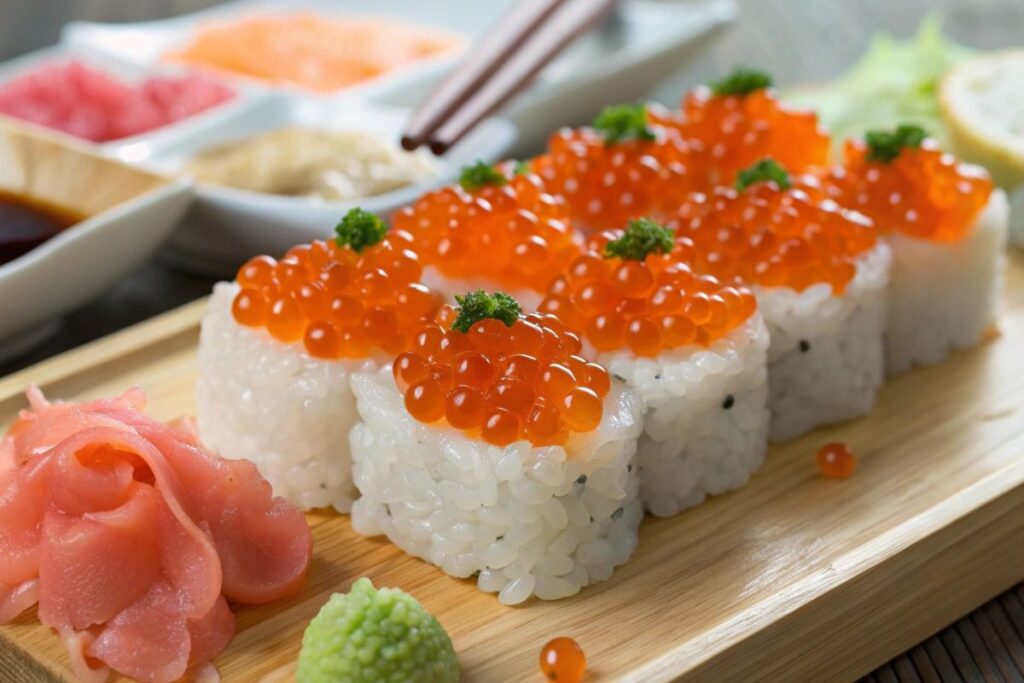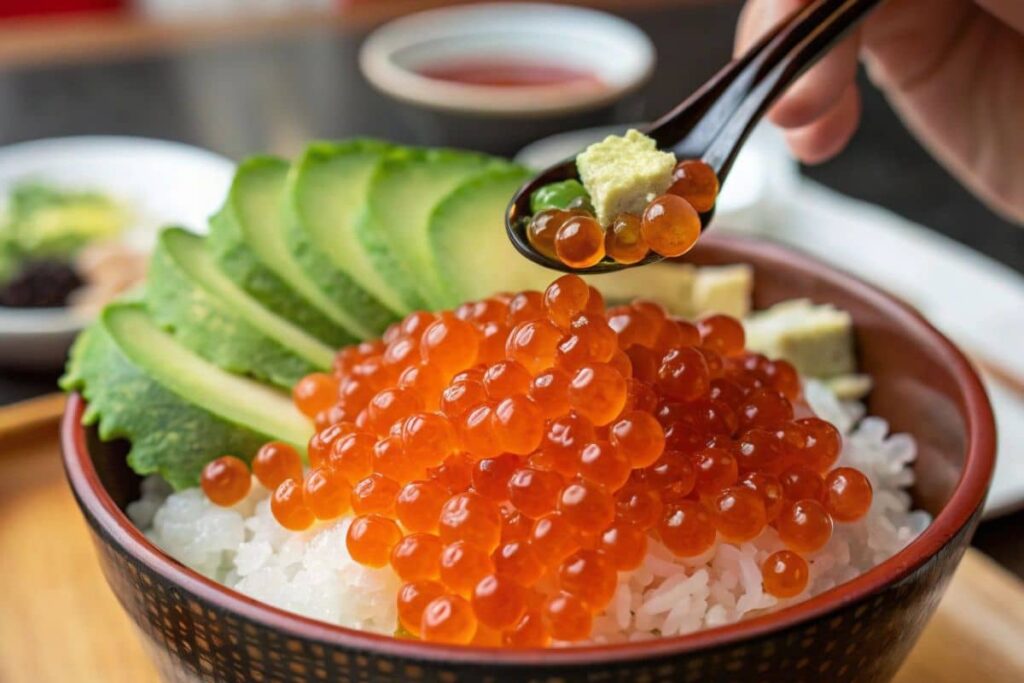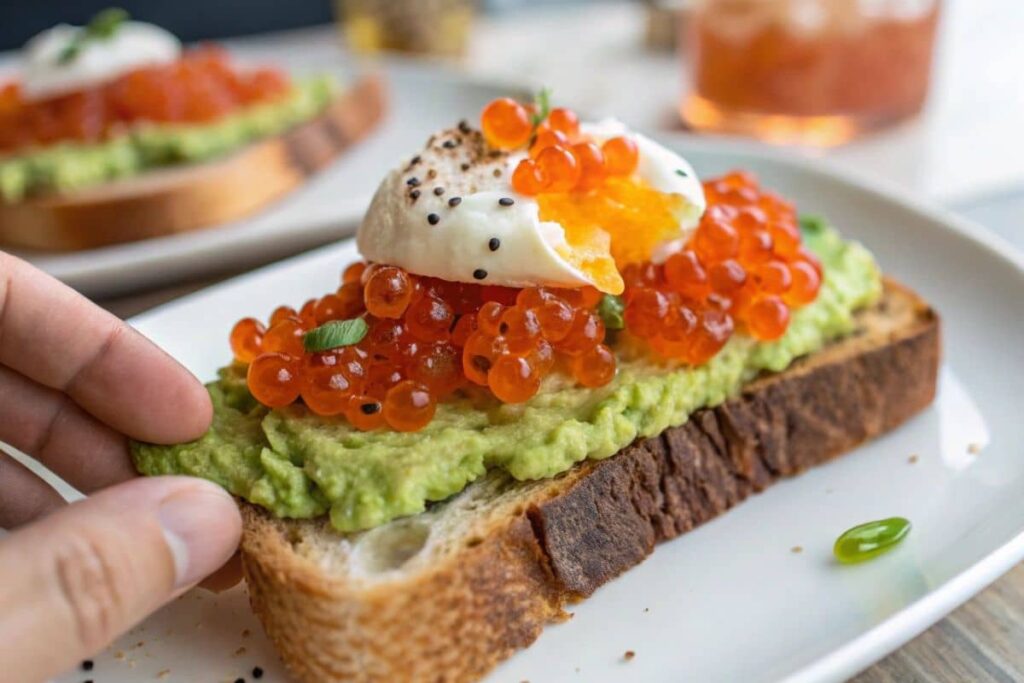Have you ever tried salmon roe, or more specifically, Ikura? If you haven’t, you’re missing out on a delightful and flavorful delicacy that’s not just tasty, but also rich in history and culture. Ikura, often associated with Japanese cuisine, is one of those ingredients that can turn an ordinary dish into something extraordinary. In this article, we’re going to explore everything you need to know about Ikura salmon roe, from its origins to how it’s made, and how to eat it for maximum flavor. Let’s dive in!
Table of Contents

What Is Ikura Salmon Roe?
Ikura, the eggs of the salmon fish, is far more than just roe—it’s a delicacy cherished worldwide for its unique texture and mild, briny flavor. In Japanese cuisine, Ikura often graces sushi, blends beautifully into rice dishes, or is savored on its own as a luxurious treat. However, the term “Ikura” isn’t merely a label; it symbolizes a deep cultural connection to the art of harvesting, preparing, and celebrating salmon roe in traditional and modern culinary practices.
The Origins of Ikura
The word “Ikura” originates from the Russian term “ikra,” meaning roe, but it was the Japanese who embraced this delicacy and gave it its unique identity. Today, Ikura is a staple in Japanese cuisine, particularly in sushi and rice dishes. The preparation of Ikura involves carefully curing the salmon eggs—a process Japanese chefs have refined over centuries to enhance the roe’s flavor and texture, turning it into the exquisite ingredient we know and love.
While Ikura is famously associated with Japanese cuisine, its appeal extends far beyond Japan. In Russia, for example, roe from salmon and other fish is a cherished staple, often served in traditional dishes. However, what sets Ikura apart in Japanese cuisine are the unique curing techniques and its versatility in dishes like sushi, ramen, and donburi bowls. These methods elevate Ikura to the status of a true delicacy, celebrated for its exquisite flavor and texture.
How Ikura Is Different From Other Types of Roe
You might be wondering, “Is Ikura the same as other types of roe, like caviar?” While both are fish eggs, they have distinct differences. The primary difference lies in the source: caviar traditionally comes from sturgeon, while Ikura is specifically salmon roe. Ikura also stands out with its larger, firmer beads compared to the smaller, softer texture of caviar. Visually, Ikura boasts a vibrant orange or red hue, whereas caviar is typically darker, ranging from black to deep gray.
The flavor profiles also set them apart. Ikura has a bold, briny taste, enhanced by its curing process, offering a unique burst of saltiness. Many describe the sensation of eating Ikura as akin to popping tiny water balloons in your mouth—a delightful, flavorful explosion that surprises with every bite!
The Process of Making Ikura
Now that you understand what Ikura is, let’s explore how it’s made. Crafting Ikura is a meticulous process that requires gentle handling of the salmon roe to preserve its delicate texture and enhance its flavor. Here’s an overview of the steps involved in creating this exquisite delicacy:
Harvesting Salmon Roe
The journey of Ikura begins with harvesting the salmon roe. This involves gently removing the eggs from a female salmon after it has been caught. The roe is then meticulously rinsed and cleaned to eliminate any impurities, ensuring the eggs remain intact and pristine. At this stage, the roe is raw and ready for the next crucial step: curing, where its flavor and texture are transformed into the delicacy we know and love.
The Curing Process
The curing process is what gives Ikura its distinct flavor and texture. The salmon roe is submerged in a carefully prepared brine solution, typically made with salt, sugar, and sometimes soy sauce or other seasonings. This brine not only preserves the roe but also infuses it with a rich, savory flavor. The level of saltiness in Ikura depends on the curing time, which can range from a few hours to a couple of days.
Shorter curing times result in a lighter, milder flavor, while longer curing produces a more robust, briny taste. The goal is always to achieve a harmonious balance of salty and savory notes, creating the perfect burst of flavor with every bite
How Long Does Ikura Last?
Fresh Ikura has a relatively short shelf life, typically lasting a few days to a week, depending on how it’s stored. Once opened, it’s essential to keep it refrigerated and consume it promptly to enjoy its best flavor and texture. The ideal way to store Ikura is in an airtight container in the fridge, which helps preserve its freshness and prevents spoilage.
For extended storage, some Ikura comes in jars or vacuum-sealed containers, which can prolong its shelf life. However, even in these forms, it’s recommended to consume it within a couple of weeks to ensure optimal taste and quality
Nutritional Value of Ikura
Ikura isn’t just a flavorful delicacy—it’s also loaded with impressive nutritional benefits! Let’s dive into what makes Ikura a nutritious choice:
Health Benefits of Ikura
Ikura is a nutritional powerhouse, packed with omega-3 fatty acids that are essential for maintaining heart health. These healthy fats help reduce inflammation, lower blood pressure, and support overall cardiovascular well-being. Omega-3s are also vital for brain health, enhancing cognitive function and promoting mental clarity—making Ikura a smart choice for your diet.
Beyond omega-3s, Ikura is an excellent source of high-quality protein, which plays a key role in muscle repair, immune support, and overall body health. Whether you lead an active lifestyle or are simply aiming for balanced nutrition, incorporating Ikura into your meals can help provide the nutrients your body needs to stay strong and healthy.
Caloric and Protein Content
Ikura is a nutrient-dense superfood, offering a significant protein boost! A small serving (approximately 1 ounce or 28 grams) contains about 40 calories and 5 grams of protein, making it an excellent addition to your meals without piling on extra calories. The high protein content also helps keep you full and satisfied, supporting muscle repair and overall health.
That said, keep an eye on the sodium content. Since Ikura is typically cured with salt, a single serving can contain around 250 milligrams of sodium. If you’re monitoring your salt intake, it’s best to enjoy Ikura in moderation as part of a balanced diet.
Vitamins and Minerals Found in Ikura
In addition to being rich in omega-3 fatty acids and protein, Ikura is packed with essential vitamins and minerals that support overall health. Some of the key nutrients include:
- Vitamin A: Helps maintain healthy vision and immune function.
- Vitamin D: Supports bone health and immune function.
- Iron: Important for blood circulation and oxygen transport.
- Calcium: Supports strong bones and teeth.
Ikura vs. Other Types of Roe
Now that we know what Ikura is and why it’s so special, let’s compare it to other types of roe, like caviar, to see how it stands out.
Ikura vs. Caviar: A Detailed Comparison
When most people think of roe, caviar—the small, black eggs from sturgeon—often comes to mind as the pinnacle of luxury. But how does Ikura compare to caviar?
Texture
Ikura stands out with its large, firm beads that deliver a delightful “pop” as they burst with flavor, creating a fun and dynamic eating experience. Caviar, on the other hand, has smaller, softer eggs that melt smoothly in your mouth, offering a more delicate texture. This makes Ikura uniquely satisfying for those who enjoy a bit of bite in their food.
Flavor
In terms of taste, Ikura has a bold and briny profile with a subtle hint of sweetness. Its flavor is intense and pronounced, making it a star ingredient in dishes. Caviar, however, is known for its mild, refined brininess, offering a more subdued and elegant flavor. Both have their unique appeal, but Ikura is definitely the choice for those who enjoy a stronger, more robust taste.
What Makes Ikura Unique?
What makes Ikura truly stand out from other types of roe is its incredible versatility in cooking. Ikura can be found topping sushi and sashimi, adding a luxurious touch to rice bowls, enhancing the flavor of salads, or even serving as a vibrant garnish for soups. Its bright orange hue and burst of flavor not only elevate the visual appeal of dishes but also add a unique depth of taste. If you’re seeking a type of roe that can bring excitement and sophistication to your meals, Ikura is the perfect choice!
Nutrition Facts (per 1 oz or 28g serving)
| Nutrient | Amount |
|---|---|
| Calories | 40 |
| Protein | 5g |
| Omega-3 Fatty Acids | 1.3g |
| Sodium | 250mg |
| Iron | 0.4mg |
| Vitamin A | 5% DV |
| Vitamin D | 10% DV |
How to Eat Ikura Salmon Roe
Now that we’ve explored what Ikura is, its rich history, and its impressive nutritional benefits, let’s dive into the best ways to enjoy this exquisite delicacy! Whether you’re trying Ikura for the first time or are already a devoted fan, understanding how to savor it can take your dining experience to a whole new level.

Common Pairings with Ikura
One of the greatest qualities of Ikura is its incredible versatility. Its bold, briny flavor complements a variety of ingredients, adding a burst of flavor that enhances any dish. Here are some popular pairings:
- Sushi and Sashimi: Of course, the most classic way to eat Ikura is atop sushi or sashimi. The delicate, salty eggs complement the tender fish and vinegary rice perfectly.
- Rice Bowls: Ikura can be served over a bowl of warm rice, often mixed with other ingredients like avocado, cucumbers, or pickled vegetables. It’s a quick and satisfying meal.
- Salads: For a light yet flavorful touch, you can sprinkle Ikura over a fresh salad, adding an extra layer of saltiness and crunch.
- Ramen or Soup: Many people enjoy adding Ikura to ramen, soups, or broths. It adds texture and flavor to the dish, and you can even hold a spoonful of it to enjoy with your soup. Just be sure to add it at the end so that it retains its texture!
Popular Dishes Featuring Ikura
Ikura can be the star of many dishes. Here are some of the most popular ways to enjoy it:
- Ikura Donburi (Ikura Rice Bowl): This is a simple yet delicious dish where a bowl of steaming rice is topped with generous servings of Ikura. Sometimes, it’s paired with a raw egg, soy sauce, and other garnishes.
- Chirashi Sushi: In this sushi bowl, Ikura is sprinkled over a bed of sushi rice along with other fish, vegetables, and garnishes. It’s a colorful and flavorful dish.
- Ikura Sushi: Perhaps the most classic way to enjoy Ikura, this dish involves a small scoop of vinegared rice topped with a dollop of fresh Ikura. It’s a bite-sized delight.
- Ikura Toast: For a more modern take, some people enjoy Ikura on top of a slice of buttered toast, sometimes with a poached egg or avocado. It’s an easy and tasty appetizer!
How to Serve Ikura for Maximum Flavor
To get the best out of your Ikura, here are a few tips:
- Serve it chilled: Ikura tastes best when it’s fresh and chilled, so keep it in the fridge until you’re ready to enjoy it. It’ll burst with flavor in your mouth!
- Avoid overcooking: If you’re adding Ikura to a hot dish, make sure to add it last to avoid cooking it. The heat will melt the roe and diminish its unique texture.
- Pair with complementary flavors: Since Ikura has a salty and briny flavor, it’s best to pair it with something mild or slightly sweet, like vinegared rice or fresh vegetables, to balance the taste.
Common Problems When Using Ikura Salmon Roe
While Ikura is undeniably a delicacy, it comes with its share of challenges. From proper storage to flavor inconsistencies, here are some common issues people encounter with Ikura and practical solutions to ensure the best experience:
How to Handle Ikura Properly
Ikura is a delicate ingredient that requires careful handling to preserve its freshness and texture. When serving Ikura, always use clean utensils and avoid touching it with your hands, as this can impact its quality. Store it in a tightly sealed container to prevent it from absorbing other odors in your fridge, keeping its flavor pristine.
For dishes that call for fresh Ikura, ensure you purchase it from a reputable source to guarantee proper handling and quality. Treating Ikura gently and sourcing it wisely will help you enjoy its vibrant flavor and satisfying texture in every bite
How to Keep Ikura Fresh After Opening
Once you’ve opened a jar or container of Ikura, you’ll want to make sure it stays fresh. Here are some tips:
- Refrigerate immediately: After opening, always store Ikura in the fridge to maintain its freshness. Keep it in an airtight container to minimize exposure to air.
- Consume quickly: While fresh Ikura can last for several days in the fridge, it’s best to eat it within a few days of opening to enjoy the full flavor.
- Do not freeze: While you can freeze other types of roe, it’s not recommended for Ikura. Freezing can alter its texture and cause the eggs to lose their signature burst of flavor.
What to Do if Ikura Tastes Too Fishy
If your Ikura has a strong, fishy taste or an unpleasant odor, it’s likely spoiled. Fresh Ikura should have a clean, slightly briny flavor—not an overpowering fishiness. If you notice a strong fishy smell, it’s safest to discard it.
To prevent this issue, always purchase Ikura from a trusted source and check the expiration date before buying. Ensuring proper storage and handling will also help maintain its freshness, allowing you to enjoy its delicate flavor without any unpleasant surprises.
Is Ikura Salmon Roe Safe to Eat?
Ikura is typically safe to enjoy, but like any raw or preserved seafood, taking certain precautions is crucial to ensure your safety and the best dining experience. Here’s what you need to keep in mind:
Raw vs. Cooked Ikura: What You Need to Know
Ikura is most often enjoyed raw, especially in sushi or sashimi, where its fresh flavor and texture truly shine. However, consuming raw seafood carries a slight risk of foodborne illness, making it essential to ensure that the Ikura you eat is fresh, sourced from a reliable supplier, and properly handled.
If you’re hesitant about raw foods, don’t worry—Ikura can also be enjoyed in cooked dishes. Incorporating it into recipes where heat is applied can reduce potential risks while still letting you enjoy its unique, briny flavor
Food Safety Tips for Ikura
Here are some tips for ensuring the safety of your Ikura:
- Buy from reputable sources: Always purchase Ikura from a trusted supplier that follows food safety guidelines.
- Check for freshness: Make sure the Ikura looks vibrant and has a fresh, salty aroma. If it smells sour or overly fishy, it’s best to avoid it.
- Consume promptly: Once opened, consume Ikura within a few days to ensure it’s fresh and safe to eat.

Sustainability of Ikura Production
In recent years, concerns about the sustainability of fish products, including Ikura, have gained significant attention. With wild salmon populations facing decline due to overfishing and environmental challenges, it’s crucial to prioritize environmentally responsible practices in Ikura production.
Opting for Ikura sourced from sustainable fisheries or farms committed to ethical and eco-friendly methods helps protect marine ecosystems while ensuring the long-term availability of this delicacy. Supporting sustainable practices allows us to enjoy Ikura responsibly while contributing to the preservation of wild salmon populations
Is Ikura Environmentally Friendly?
The production of Ikura can have notable environmental impacts, but many producers are adopting sustainable practices to mitigate these effects. One common approach is sourcing roe from farmed salmon, which helps ease the strain on wild salmon populations.
However, farmed salmon is not without its challenges. Issues like water pollution, the spread of diseases, and the impact on surrounding ecosystems remain concerns. To address these, sustainable fish farms are implementing improved practices, such as using closed-containment systems, better feed management, and stricter disease control measures.
By supporting producers committed to sustainability, we can enjoy Ikura while promoting a more eco-conscious approach to its production.
The Impact of Overfishing on Salmon Roe
Overfishing poses a significant threat to the sustainability of salmon roe. When wild salmon populations are overexploited, it not only jeopardizes the species but also impacts the availability of high-quality roe.
To address this issue, some producers are adopting eco-friendly farming methods or actively participating in wild salmon conservation initiatives. These efforts include responsible fishing quotas, habitat restoration, and innovative farming practices that minimize environmental harm.
By choosing Ikura from sustainable producers, consumers play a vital role in protecting these precious resources. Supporting ethical practices helps ensure the long-term health of wild salmon populations and the continued enjoyment of this delicacy.
Where to Buy Ikura Salmon Roe
If you’re eager to try Ikura or looking to stock up, you’ll be glad to know it’s widely available at specialty food stores and online retailers. To ensure you’re getting the best quality, here are some helpful tips:
How to Choose High-Quality Ikura
When buying Ikura, focus on freshness and quality. Look for roe that’s vibrant, clear, and firm, with no signs of mushiness or discoloration. Fresh Ikura should have a clean, briny aroma that evokes the ocean—not a sour or overly fishy smell. For the best experience, purchase from a reputable source, such as a specialty store or retailer that focuses on Japanese cuisine or high-quality seafood products. This ensures you’re getting Ikura that’s both delicious and safe to eat.
The Best Places to Buy Ikura
Some of the best places to buy Ikura include:
- Japanese grocery stores
- Online seafood retailers
- Specialty food markets
Frequently Asked Questions About Ikura Salmon Roe
How Long Does Ikura Last After Opening?
Once opened, Ikura should be consumed within 3 to 5 days for optimal freshness. Always store it in the refrigerator in an airtight container.
Can You Freeze Ikura Salmon Roe?
It’s not recommended to freeze Ikura, as freezing can alter its texture and flavor. Fresh Ikura is best enjoyed within a short period after opening.
Is Ikura Good for a Special Diet?
Ikura can be a great addition to a balanced diet. It’s high in protein and omega-3 fatty acids, making it a healthy option for those looking to boost their nutrient intake. However, if you’re watching your sodium intake, it’s important to consume Ikura in moderation.
Conclusion: Is Ikura Salmon Roe Worth the Hype?
Ikura salmon roe is a delicious and healthy delicacy that brings a burst of flavor to any dish. Whether enjoyed on sushi, in a rice bowl, or simply on its own, it’s sure to impress. But if you’re curious about other healthy foods, don’t miss out on our purple sweet potato recipe for a tasty and nutritious twist. And if you’re wondering if salmon roe is healthy, check out our article on Is Salmon Roe Healthy?. Want to know how to use it in your sushi? We’ve got the perfect guide in Salmon Roe Sushi. You can also compare it to other types of roe in our Salmon Roe vs Caviar article!
Ready to dive into the world of Ikura? With all the info you’ve got here, you’re all set to enjoy this tasty treat. Happy eating!






